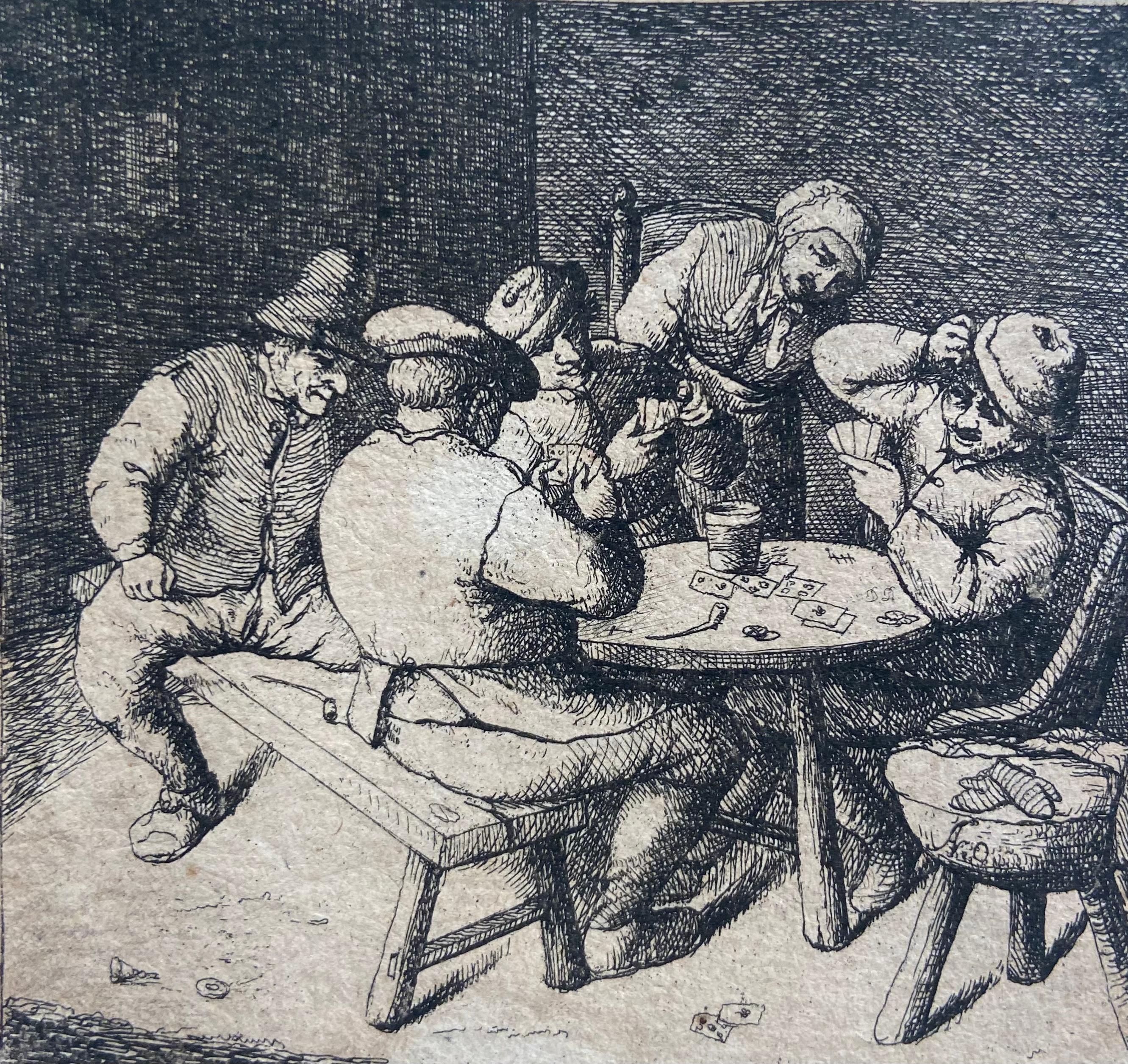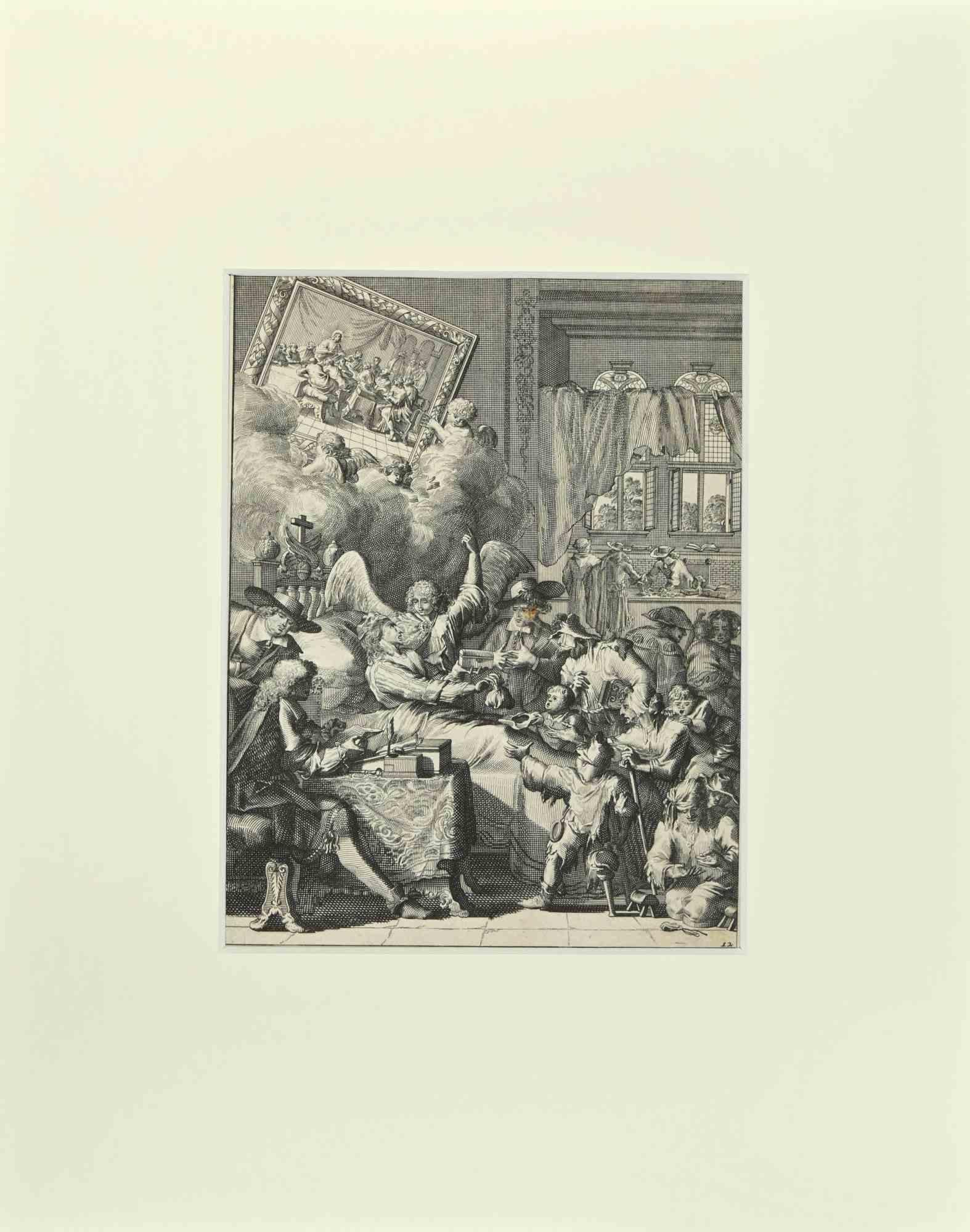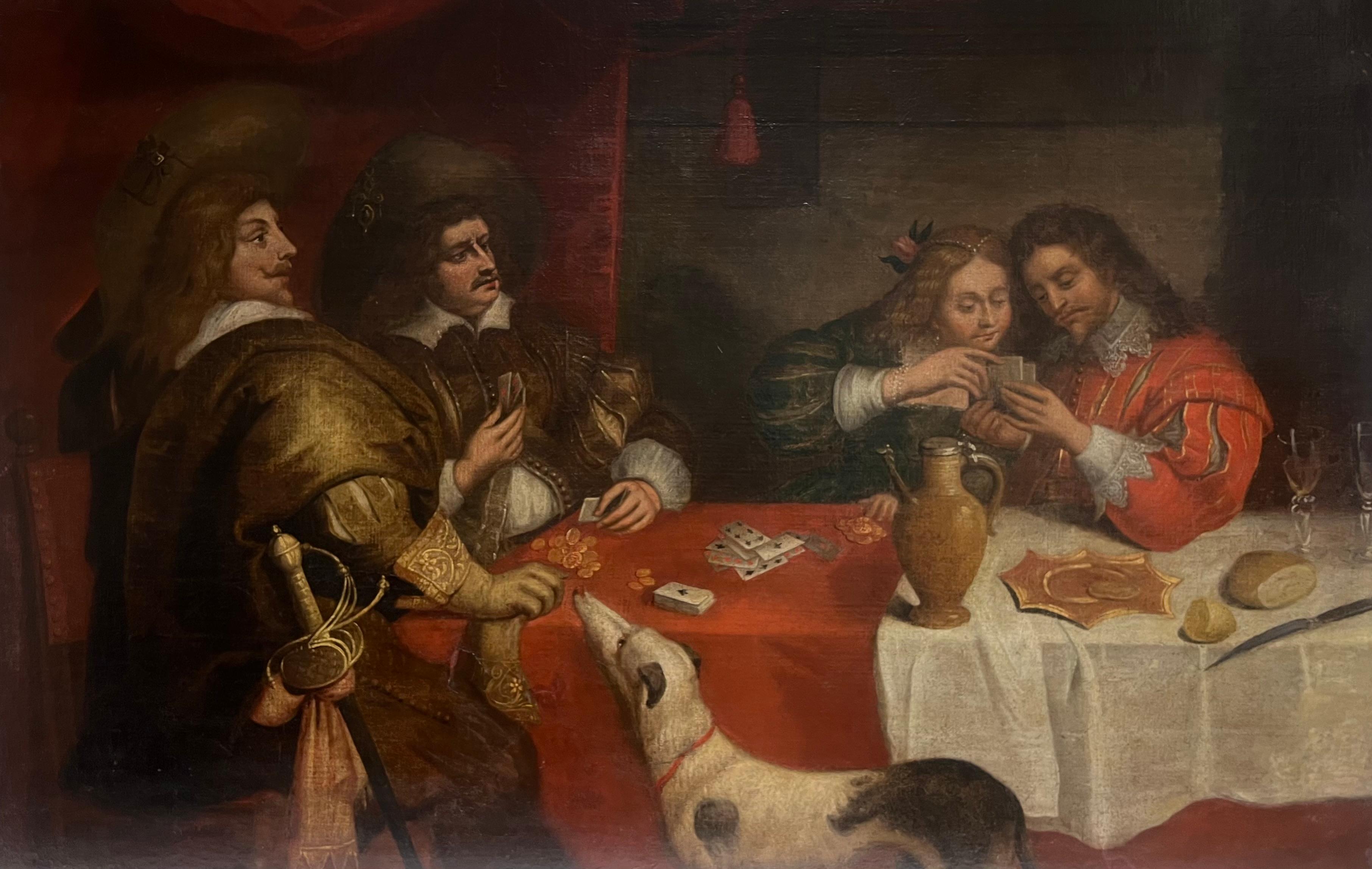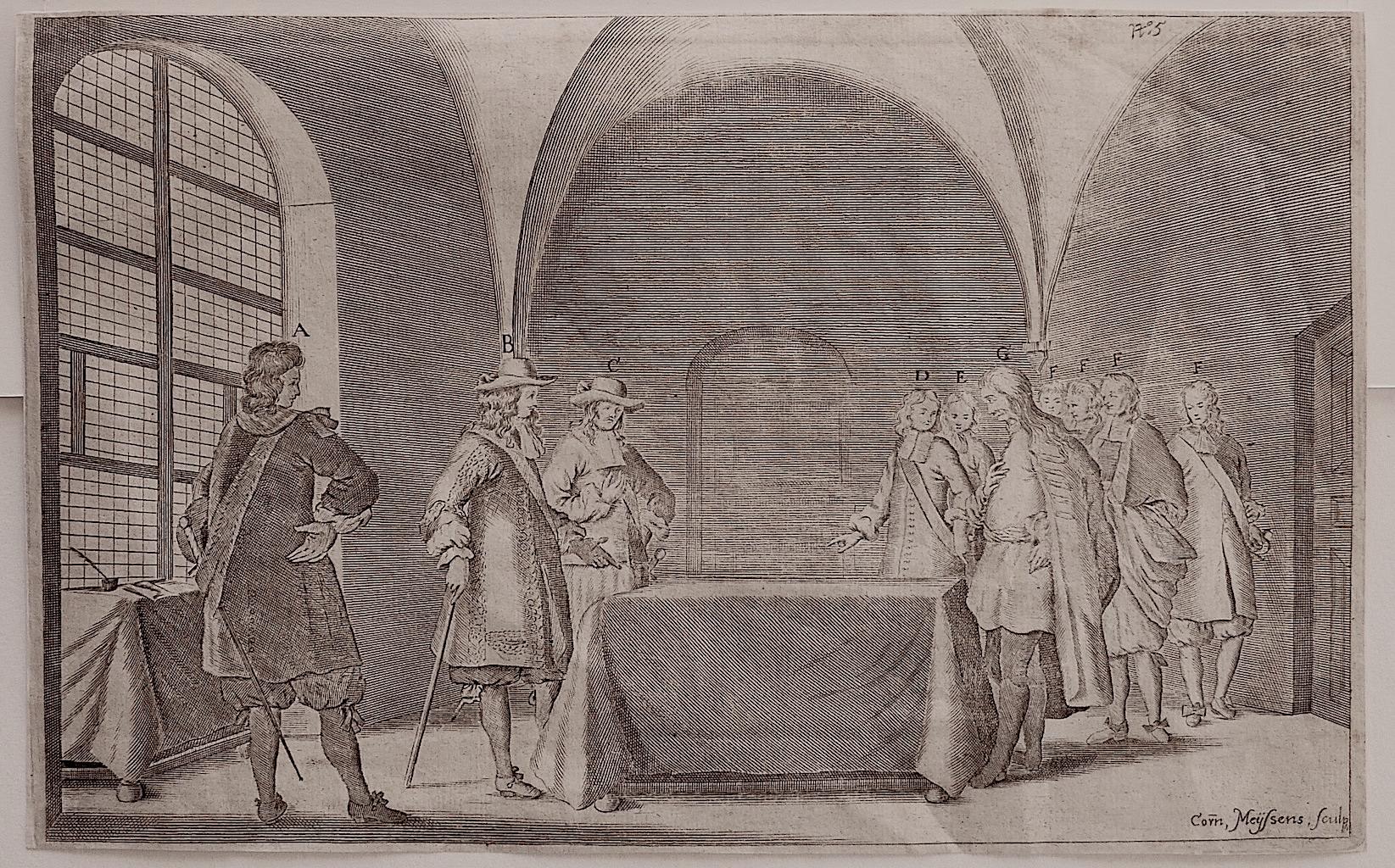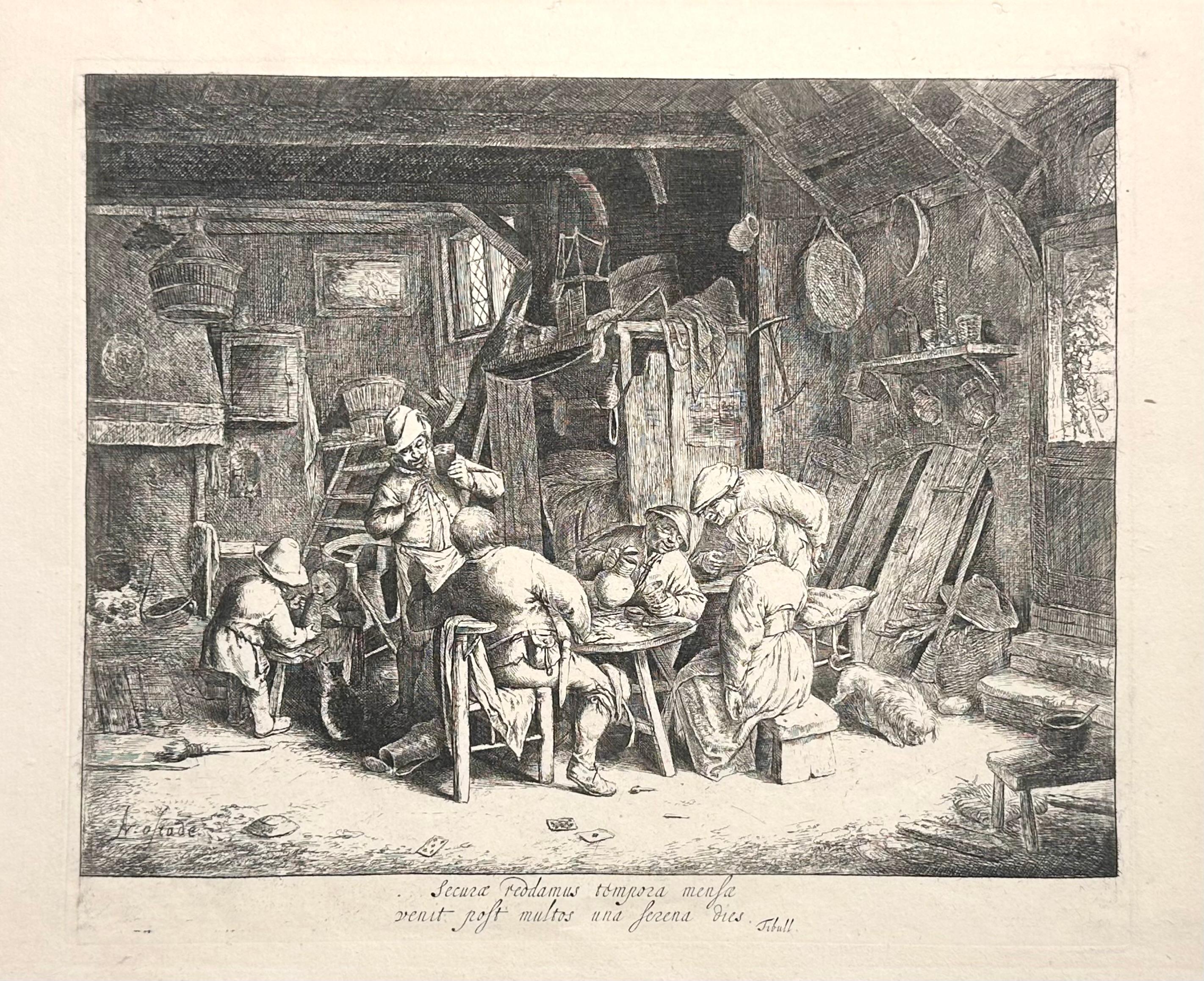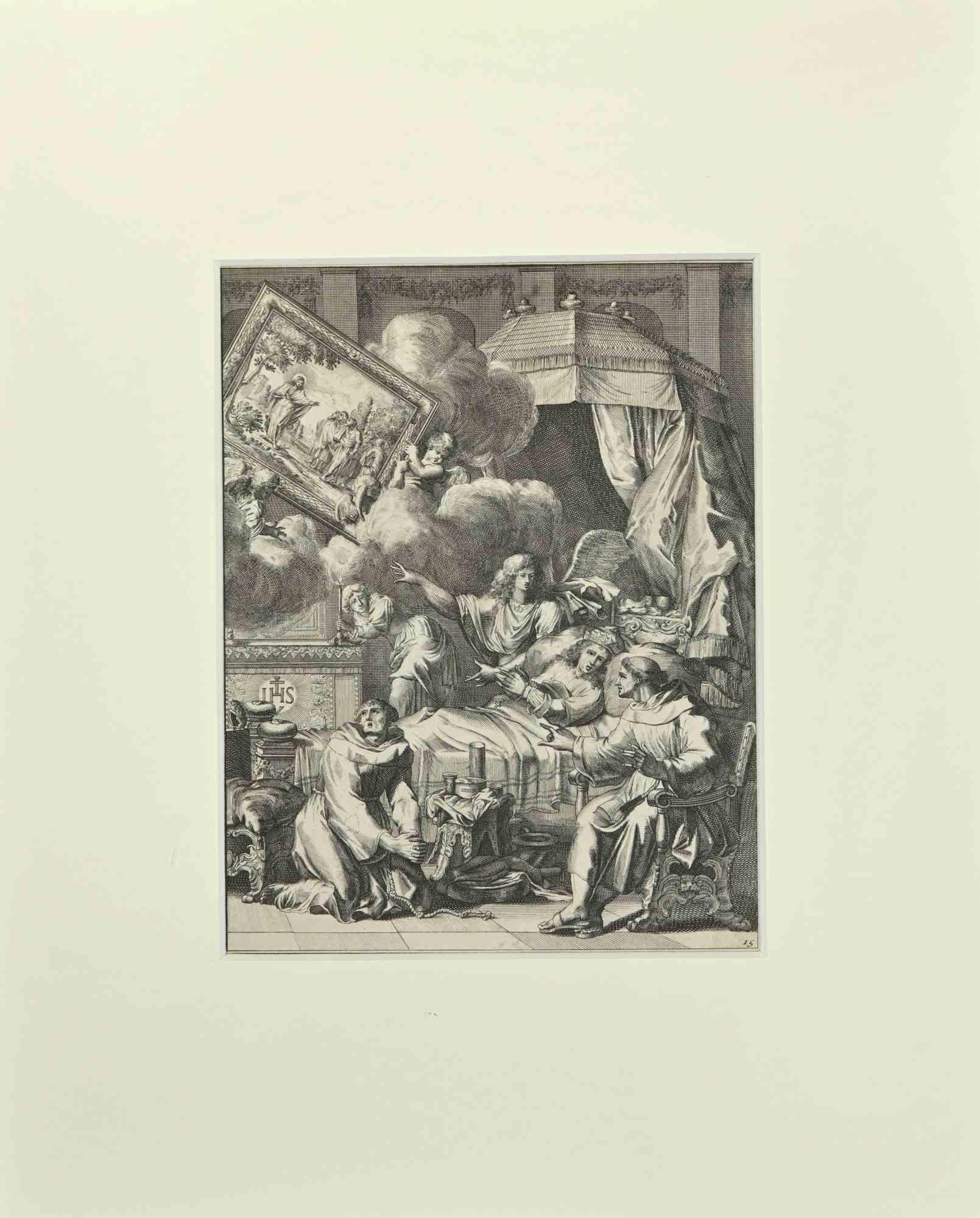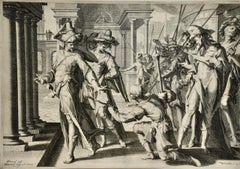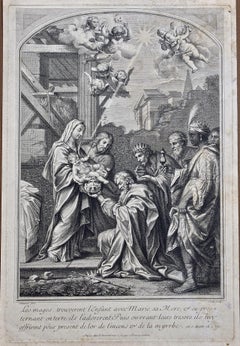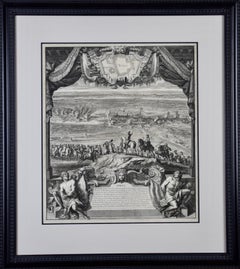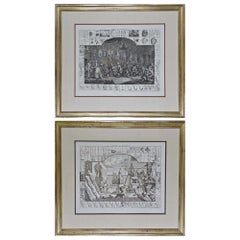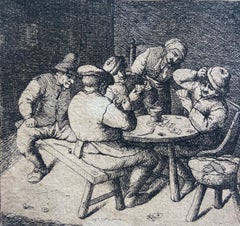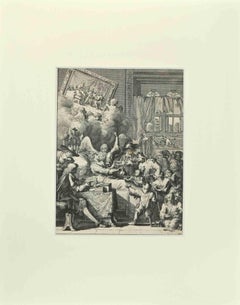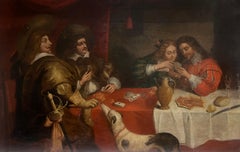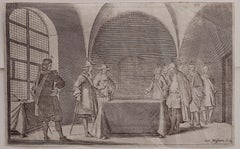Items Similar to The Card Game: An Early 17th Century Engraving by A. Voet after Cornelis de Vos
Want more images or videos?
Request additional images or videos from the seller
1 of 12
Alexander VoetThe Card Game: An Early 17th Century Engraving by A. Voet after Cornelis de Vos1632
1632
$6,975
£5,209.99
€6,040.15
CA$9,684.61
A$10,855.20
CHF 5,651.99
MX$132,546.69
NOK 71,759.69
SEK 68,021.73
DKK 45,066.09
Shipping
Retrieving quote...The 1stDibs Promise:
Authenticity Guarantee,
Money-Back Guarantee,
24-Hour Cancellation
About the Item
A 17th century engraving entitled "The Card Game" by old master artist Alexander de Voet after a painting by Cornelis de Vos, created in 1632. The painting by de Vos is in The National Museum, Stockholm, Sweden (Inv. #689, Cat. 1990, pg. 383). The engraving by Voet is a technical masterpiece, which is quite rare and infrequently seen in museum collections and is rarely for sale. It is in the collections of The British Museum, The Rijksmuseum and The National Galleries of Art, Washington, DC. Reference: Holstein 17 (only state)
This beautiful engraving is presented in a cream-colored mat, measuring 20" x 26". The sheet measures 13.5" x 16.5". The engraving is a very fine impression in very good condition. It is trimmed along the border on the upper and left sides and beneath the inscription below the image. It is laid down on an album leaf.
The engraving depicts two elegantly dressed gentlemen on the left awaiting the couple on the right to play their hand. The man is showing his hand to a woman. The scene is one of splendid exuberance. All of the players appear quite wealthy. They are seated at a long table set with a silver jug of wine, a wine glass, bread and butter or another spread. The handsome young man on the right shows his hand to an attractive young woman as their heads touch romantically. A young attendant stands behind the two men on the left, staring at their cards. The six-line poem in French below the image informs us that the man on the right is the prodigal son, who is squandering his worldly possessions in bad company; gambling, loose women and wine lead to perdition. Gambling was considered one of the seven cardinal sins in the 17th century, when the painting and this engraving were created. Even the dog seems to be concerned.
Cornelis de Vos (1584-1651) was a Flemish painter, draughtsman and art dealer from Antwerp, best known for his portraits, but also for his historical, religious and genre paintings. He was a contemporary of Peter Paul Rubens and often collaborated with him on large paintings.
Alexander Voet (c1613-1690) was an engraver in the Rubens school in Antwerp. His style resembles another old master engraver, Paulus Pontius, who is thought to have been his mentor. Voet often created engravings after paintings by other great contemporary Dutch artists in addition to Cornelis de Vos, including: Peter Paul Rubens, Anthony van Dyck, Cornelis de Wael and Erasmus Quellinus, the Younger.
- Creator:Alexander Voet (1613 - 1689, Flemish)
- Creation Year:1632
- Dimensions:Height: 20 in (50.8 cm)Width: 26 in (66.04 cm)
- Medium:
- Movement & Style:
- Period:1630-1639
- Framing:Framing Options Available
- Condition:
- Gallery Location:Alamo, CA
- Reference Number:Seller: # 22151stDibs: LU117327270572
About the Seller
5.0
Platinum Seller
Premium sellers with a 4.7+ rating and 24-hour response times
Established in 2011
1stDibs seller since 2019
285 sales on 1stDibs
Typical response time: 2 hours
- ShippingRetrieving quote...Shipping from: Alamo, CA
- Return Policy
Authenticity Guarantee
In the unlikely event there’s an issue with an item’s authenticity, contact us within 1 year for a full refund. DetailsMoney-Back Guarantee
If your item is not as described, is damaged in transit, or does not arrive, contact us within 7 days for a full refund. Details24-Hour Cancellation
You have a 24-hour grace period in which to reconsider your purchase, with no questions asked.Vetted Professional Sellers
Our world-class sellers must adhere to strict standards for service and quality, maintaining the integrity of our listings.Price-Match Guarantee
If you find that a seller listed the same item for a lower price elsewhere, we’ll match it.Trusted Global Delivery
Our best-in-class carrier network provides specialized shipping options worldwide, including custom delivery.More From This Seller
View All"Allegory of Justice": A 17th Century Old Master Engraving by van Swanenburg
By Willem van Swanenburg
Located in Alamo, CA
This old master engraving entitled "Allegorie op de Rechtspraak" is by Willem van Swaanenburg after a painting by Joachim Wtewael, published by Ch...
Category
Early 1600s Old Masters Interior Prints
Materials
Engraving
The Gift of the Magi: An 18th C. Religious Engraving by Vale, After Calmarat
Located in Alamo, CA
This is a very rare early 18th century old master religious themed engraving entitled "Les Mages...Trouverent l'Enfant avec Marie sa Mere, et se prosternant entere ils l'adorent Puis ouvrant leurs tresors ils tuy offrirent pour present de lor de l'encens et de la myrrhe" by S. Vale after Calmaret, published in Paris by Pierre Drevet (1663-1738). The scene depicts the Magi bowing before Jesus, who is held by his mother Mary, and bringing him gifts of gold, frankincense and myrrh to demonstrate their adoration and respect. Winged cherubs fly overhead and a ray of light is focused on the spiritual couple. A cattle stall and buildings are in the background and a crown and scepter are dropped in the foreground, symbolically demonstrating that these nobles place Jesus above their titles and rank. Little is known about the artist Calmarat or the engraver S...
Category
Early 18th Century Old Masters Portrait Prints
Materials
Engraving
Daniel Marot's The Siege of the Dutch Fortified City of Ypres by Louis XIV
By Daniel Marot
Located in Alamo, CA
"Ypres, Grand Ville Riche & Marchande" is an engraving and etching by Daniel Marot (le Vieux) (1661–1752). It depicts a view of the siege of the city of Ypres and its citadel on the left in the Spanish Netherlands by Louis XIV's troops. This battle took place between March 18 and March 25, 1678, as part of the Franco-Dutch War. Marot illustrated in great detail (best appreciated with magnification) the French attack on the strong pentagonal citadel on the extreme left, which had been built recently in anticipation of a French attack. The trenches built by the French approaching the town are seen on the right. King Louis XIV can be seen in the foreground surveying the battle mounted on his white horse, surrounded by his officers and troops.
The print is presented in an attractive ornate black wood frame with a cream-colored double mat with a black inner trim. It is glazed with plexiglas. The frame measures 25.38" x 22.63" x .88". The engraving, frame, mat and glazing are in excellent condition.
Artist: Daniel Marot (1661–1752) was also called "Le Vieux". He was the son of the famous architect, Jean Marot. Marot had diverse interests and talents. In addition to his art, he designed garden projects, architectural ornaments, furniture, and even upholstery. Marot as a Huguenot protestant was forced to leave France in 1685 following the revocation of the Edict of Nantes. He emigrated to Holland, where he worked for William of Orange (an arch enemy of his former employer Louis XIV). Marot was largely responsible for the interiors of Williams palace at the Loo. In 1694 he went Britain as William had married Queen Mary and he had become King William III of England. He later returned to Holland in about 1698 and died in the Hague in 1752. He left a lasting legacy on the decorative arts in the Netherlands, where his grand version of the Louis XIV style remained popular into the 1730s.
Historical Background: In October 1677, Mary Stuart, niece and possible successor of Charles II of England, married Louis XIV's arch enemy William III of Orange...
Category
Late 17th Century Old Masters Landscape Prints
Materials
Engraving, Etching
William Hogarth's "Analysis of Beauty": A Set of Two Framed 18th C. Engravings
By William Hogarth
Located in Alamo, CA
The two plates in this set were created utilizing both engraving and etching techniques by William Hogarth in 1753, originally as illustrations of his book on aesthetics, entitled "Analysis of Beauty". Due to their popularity, these plates were later published separately. The publication line in the lower right reads: "Designed, Engraved, and Publish'd by Wm. Hogarth, March 5th 1753, according to Act of Parliament." Hogarth's original copper plates were refurbished where needed by James Heath and engravings were republished in London in 1822 by Braddock, Cradock & Joy. This was the last time Hogarth's copper plates were used for printing. Most were melted during World War I for the construction of bombs.
These large folio sized "Analysis of Beauty" engravings are presented in antiqued gold-colored frames with double mats; the outer silk mats are light brown-colored and the inner mats are dark brown. Each frame measures 27.38" x 31.25" x 1.13". There is one tiny spot in the right margin of plate 1 and another in the lower margin; the latter could be from the printing process. The prints are otherwise in excellent condition.
The "Analysis of Beauty" series is in the collection of many major museums, including: The British Museum, The Metropolitan Museum of Art, The Tate Museum, The Chicago Art Institute and The Fine Arts Museums of San Francisco.
The first engraving (Plate 1) depicts a courtyard of statues which is filled with some of the most famous works of classical sculpture. The most important sculptures are surrounded by less impressive works. The Medicean Venus (#13) is in the center with a statue of Julius Caesar (#19) to the right, elevated on a pulley with a short, overdressed Brutus stands over the falling Caesar. The Apollo Belvedere (#12) is next. A judge stands to the right with his foot on a cherub (#16). Another crying cherub holds a gallows and wipes his tears with the judge's robe.
A sphinx (#21) and the drunken Silenus (#107) are below the Venus. Michaelangelo's torso (#54) and a statue of Antonius (#6) are seen in the foreground. The Farnese Hercules (#3) and a bust of another Hercules (#4) under two statuettes of Isis are also included in the scene.
The key to these objects is included in the form of a serpentine line winding around a cone (#26), Hogarth's "Line of Beauty". For Hogarth the winding line is an essential element of beauty in art. Hogarth's theory of beauty is communicated in this plate.
Plate 2 is thought to represent the Wanstead Assembly, with the Earl of Tynley and his household. It is an adaptation of a scene in the Happy Marriage series, which complements Hogarth's Marriage à la Mode...
Category
Mid-18th Century Old Masters Interior Prints
Materials
Engraving, Etching
N. Lambert Seigneur de Thorigny: 17th C. Engraved Portrait After Largillière
By Nicolas de Largillière
Located in Alamo, CA
This is a 17th century engraving entitled "Messire Nicolas Lambert Seigneur de Thorigny, Conseiller du Roy" by Pierre Drevet after a painting by Noicolas de Largillière, published in Paris in 1698. This portrait depicts a three-quarter length view of Nicolas Lambert de Thorigny, who is dressed in elaborate robes and collar of a wealthy Parisian nobleman of the time. He is seated directed to the left and looking directly at the viewer. He is holding an inscribed note in his right hand. A magnificent billowing curtain is in the background. Lambert's coat of arms is shown in the center of the lower inscription area. In the inscription area is lettered with title, production detail: "Nic. Largilliere pinxit" and "Petr. Drevet sculpsit", and publication detail: "Se vend a Paris chez Drevet rüe du Foin au coin du College de Maître Gervais".
Nicolas Lambert, Seigneur de Thorigny (1600-1664), was a French nobleman and military commander who lived in the 17th century. He served in the French army during the Thirty Years' War, a conflict that took place from 1618 to 1648 and involved many European powers. Lambert fought in several battles during the war and rose to the rank of colonel. After the war, Lambert returned to France and became involved in politics. He served as a member of the Estates General, a legislative body that advised the king, and as a governor of several provinces. He was a counsellor and confidant of King Louis XIV. He had the title of Président de la Chambre des Comptes. He also became a member of the French Academy of Sciences, a prestigious institution that promotes scientific research and scholarship. Lambert was known for his military expertise, his intelligence, and his commitment to public service. He iInherited the Hôtel Lambert in Paris from his brother Jean Baptiste in 1644 and hired some of the most prominent artists of the time, including Charles Le Brun to decorate and furnish the building.
This beautiful old master engraving was created with impressive detailed technique. It is printed on laid, chain-linked paper. The sheet measures 18.5" high and 13.38" wide. The sheet is adhered to an archival backing paper at the top. There is a faint horizontal center fold and mild discoloration in the inscription area and in the upper margin on the right, with mild wrinkling here. The print is otherwise in very good condition, considering its age. This engraving is so rare, that no comparable prints could be identified for sale online. It is currently only listed in museum collections, including: The Metropolitan Museum of Art, The British Museum, The Louvre, The Riksmuseum, The Victoria & Albert Museum, The Fitzwilliam Museum at the U. of Cambridge, The Boston Museum of Fine Arts, Harvard Art Museums, The Finnish National Museum, The Philadelphia Museum. It is shown in the Metropolitan Museum's Cataloque of French paintings entitled: "French Paintings in The Metropolitan Museum of Art, published in 2018, page 36. The page is included in the photos.
Nicolas de Largillière (1656-1746) was a French portrait painter who achieved great success and acclaim during the late Baroque and Rococo periods. He was born in Paris and trained under the painter Antoine Goubeau. He studied in Antwerp and London before returning to France. While in England he was a favorite painter of King Charles II and King James II of England...
Category
Late 17th Century Portrait Prints
Materials
Engraving
18th Century Engraved Portrait of George Savile, Marquis of Halifax by Houbraken
By Jacobus Houbraken 1
Located in Alamo, CA
A superb 18th century engraved portrait of George Savile, Marquis of Halifax, Plate 82 in "The Heads of Illustrious Persons of Great Britain", written by...
Category
Mid-18th Century Realist Portrait Prints
Materials
Laid Paper, Engraving
You May Also Like
The Card Players, Late 18th Century British Etching
Located in London, GB
Etching laid on paper
Image size: 3 1/4 x 3 1/4 inches (8 x 8 cm)
This etching is after a work by Adriaen van Ostade, a 17th century Dutch artist.
This wonderful etching shows a gr...
Category
Late 18th Century Interior Prints
Materials
Etching
Price Upon Request
La Manière de se Bien Preparer à La Mort - Etching by Romeyn de Hooghe - 1700
By Romeyn de Hooghe
Located in Roma, IT
La Manière de se Bien Preparer à La Mort is an etching by Romeyn de Hooghe from the Suite by Chertablon de la Vigne, La manière de se bien preparer à la mort. Antwerp: Gallet 1700.
...
Category
Early 1700s Modern Figurative Prints
Materials
Etching
Huge 17th Century Flemish Old Master Oil Painting Figures Playing Cards
Located in Cirencester, Gloucestershire
The Card Players
Flemish Old Master, 17th century
based on a version (in reverse) of a painting by Cornelis de Vos (Flemish 1584-1651)
oil on canvas, unframed
Canvas: 39 x 62 inches
...
Category
Mid-17th Century Old Masters Figurative Paintings
Materials
Oil, Canvas
$12,918 Sale Price
30% Off
Interior Meeting - Original Etching by Cornelis Meyssens - 17th Century
Located in Roma, IT
Interior Meeting is an original etching realized by Cornelis Meyssens ( 1640-1573).
Good conditions, except for some foldings.
Included a Passepartout: 34 x 49 cm
The artwork repres...
Category
17th Century Baroque Figurative Prints
Materials
Etching
Van Ostade, Le Gourmet en compagnie, c.1664
By Adriaen van Ostade
Located in Torino, IT
ADRIAEN VAN OSTADE, Haarlem 1610 - 1684
Le Gourmet en compagnie, 1664 c.a
Original etching and drypoint, signed in plate at lower left.
Bibliography: Godefroy 50 VII/XII. (mm. 219x2...
Category
1660s Old Masters Interior Prints
Materials
Etching
La Manière de se Bien Preparer à La Mort - Etching by Romeyn de Hooghe - 1700
By Romeyn de Hooghe
Located in Roma, IT
La Manière de se Bien Preparer à La Mort is an etching by Romeyn de Hooghe from the Suite by Chertablon de la Vigne, La manière de se bien preparer à la mort. Antwerp: Gallet 1700.
...
Category
Early 1700s Modern Figurative Prints
Materials
Etching
